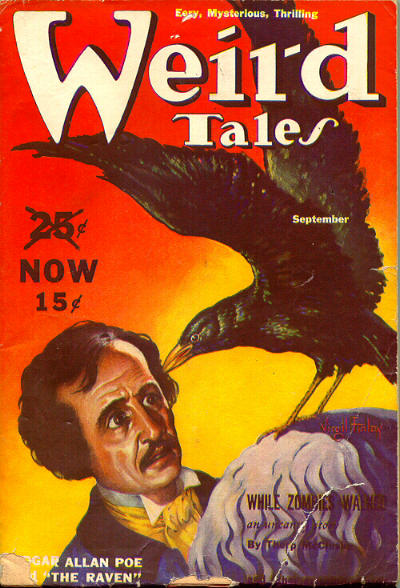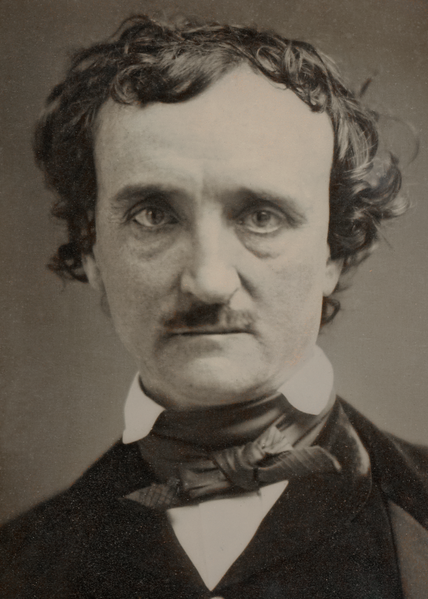
The American writer Edgar Allan Poe (1809 –1849) is famous for short stories with themes of horror, mystery, and science fiction. These scary and exciting tales have been adapted into films and television shows, and even some of Poe’s poems have inspired films. Of these, possibly the most famous is The Raven in which a bird delivers a sad message about the past never happening again. Poe’s stories often had sad messages, but they were expressed with lots of awareness and understanding of ideas and current scientific trends of his time. Aspects of psychology and astronomy may be found in Poe’s works that fascinate scientists even today.
In the 1840s, he published a prose poem Eureka which gave a surprisingly accurate general description of what is known today as the Big Bang Theory, about how the universe began. Readers of his time thought Poe was just imagining things, since no one would think of the Big Bang Theory for many years. Poe described how the universe began with a single particle, and other atoms radiated from it in different sizes and densities, so that gravity pulled them together into matter. Poe’s Eureka also suggested that space and time could be equated; some stars radiate no light; another force counteracts gravity; other universes coexist with ours in a series; and our universe might collapse into a particle one day, restarting the Big Bang process. All of these ideas suggested by Poe are now taken seriously by high-level scientific researchers. Poe admitted that he was not a scientist, and many of his other claims are wrong. Even for readers who are not interested in science or how the universe began, Poe can be exciting to read. He is sometimes called the founder of detective fiction. Arthur Conan Doyle, the British writer who created Sherlock Holmes, wrote about Poe’s stories featuring a French detective:
Each is a root from which a whole literature has developed…. Where was the detective story until Poe breathed the breath of life into it?
Among other admirers of Poe was the French fantasy author Jules Verne, who produced The Sphinx of the Ice Fields, a follow-up to Poe’s novel The Narrative of Arthur Gordon Pym of Nantucket. Both books have been reprinted in a single edition, which has been recently acquired by the Thammasat University Libraries. Another of Poe’s many interests that makes him appeal to young readers today was his obsession with codes and secret writing. He enjoyed being an amateur cryptographer, someone who solved codes for fun, and one of his most admired short stories, The Gold-Bug, involves a secret message leading to buried treasure. This story would especially inspire one young reader, William Frederick Friedman, who grew up to become a United States Army cryptographer who ran the research division of the Army’s Signal Intelligence Service in the 1930s, and deciphered an essential Japanese military code during the Second World War.

Thailand and Edgar Allan Poe
Even if they have not read his books, Thai people know about Edgar Allan Poe. At Sukhumvit Soi 38, The Book Shop café in the Ashton Condo complex offers an Edgar Allan Poe cocktail. priced at 290 baht, it is made with vodka, fresh citrus, palm sugar and pink grapefruit reduction. Like many users of Thai English, the cafe spells the writer’s middle name incorrectly as Allen, instead of Allan. While there are people who spell their name Allen, for example the film director Woody Allen, this is not the way Poe’s middle name was spelled. To show respect, writers of theses and research papers should always try to spell the full name of a writer the right way. One way to do so is to get into the habit of Googling a name each time it must be used in a paper or thesis, even if the writer is certain of how to spell it. That way, the name can be cut and pasted into the Word document, and spelling mistakes can be avoided that would ordinarily occur if we just write a name the way we think it should look. Since Google search takes less than a second to do, and we would have to write out a name anyway in order to add it to a paper or thesis, we are not wasting any time by adopting this safety procedure to guarantee we are correct in how we present anyone’s name, not just Edgar Allan Poe’s.
Further inspiration.
In 2014 the young picture book illustrator Muenfan “Pink” Sapanake, a graduate of Silpakorn University, told The Bangkok Post about her admiration of Poe, and especially the illustrations that have been added over the years to his stories:
The book is The Black Cat — a renowned short story by Edgar Allan Poe. It’s right at the top of the macabre genre list and I consider myself a big fan of such books. Although when I read it, the words fall short and don’t give me the spine-chilling effect I expect, the illustrations in this book belong to the masterclass… Illustrators are often inspired by paintings. Yet book illustrators are unique because our works must relate to the written story. Our images cannot stand alone and the image will be better communicated with text.

Historical precedent
All Thais know that His Majesty King Vajiravudh (King Rama VI) was also an enthused reader of Poe, and adapted the Poe mystery story The Murders in the Rue Morgue into Thai language. This adaptation of what is sometimes called the first modern detective story is analyzed in a 2009 study in Manusya: Journal of Humanities. Written by Assistant Professor Thosaeng Chaochuti, Ph.D. Department of Comparative Literature, Faculty of Arts, Chulalongkorn University, the article discusses how by translating Poe, King Rama VI was showing an interest in getting closer to Western styles, while also remaining very much within Thai traditions. First published in 1905, Phu rai kha khon thi Bangkhunphrom (The Murderer of Bangkhunphrom), then-Prince Vajiravudh’s adaptation of Poe’s The Murders in the Rue Morgue
revolves around a Thai detective named Nai Thong-in Rattananet whose help is solicited by the local police when they are stumped by the mysterious murder of Nai Rod. In the end, Nai Thongin is able to solve the murder and to reveal that a pet orang-outan of a farang is responsible for the crime. Although the Thai detective is clearly not of noble birth (hence the commoner title Nai), he arguably stands, as Rachel Harrison (2009: 344) argues in “‘Elementary, My Dear Wat’—Influence and Imitation in the Early Crime Fiction of ‘Late-Victorian’ Siam,” for the Thai aristocracy or more precisely for Prince Vajiravudh himself. Harrison writes: “Crown Prince Vajiravudh and his fellow ruling elite were deeply motivated by a quest for knowledge that was in turn a quest for power” over the many unruly Others within the country. Thus, the detective who embodies the ideals of superior reason and intellect can easily be seen as standing in for this elite group of Thai nobility. In order to situate Nai Thong-in within the civilizational hierarchy, Prince Vajiravudh arguably used the same techniques that he and his fellow members of the aristocracy employed in real life. He did, namely, construct a primitive Other against which his literary alter-ego appears all the more civilized. This Other takes the form of the murderous orang-outan that is conveniently found in Poe’s original tale and that is described in Vajiravudh’s adaptation as child-like and incapable of language. The narrator calls it, at one point, a “tua-buea,” which is a mythological creature whose defining characteristic is the lack of kneecaps and language capability (Vajiravudh 2006: 169)… Although Thai people did not have last names at the time that the story was written, Prince Vajiravudh decided to give his detective one. So instead of the simple Nai Thong-in, the detective becomes Nai Thong-in Rattananet. This act of giving his detective a last name could be seen as an attempt to imitate a European custom so as to make him appear civilized. Walter Vella (1978) proposes the same idea in Chaiyo! King Vajiravudh and the Development of Thai Nationalism when he writes about the 1913 law that required every Thai person to acquire a last name. The real reason behind this law was, Vella argues, the emulation of the West, the supposed paragon of civilization…. [Prince Vajiravudh made] the owner of the orang-outan a farang who has to ask for the Thai detective’s help in capturing the animal. While Nai Thong-in and the Westerner converse in English, which potentially points to an imbalance of power between the two, their conversation is translated into Thai in the story, and the pronouns that Prince Vajiravudh chooses for the detective and the owner of the ape reflect not only the highest respect that the two characters have for each other but also the equality between them.

(All images courtesy of Wikimedia Commons)
